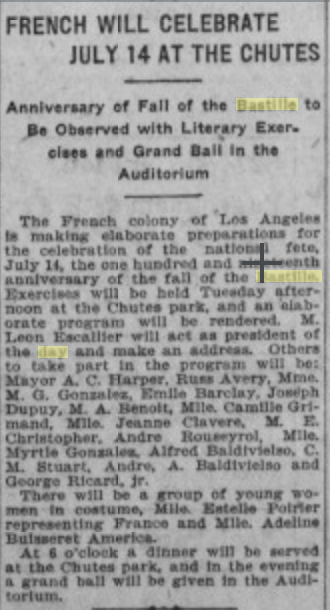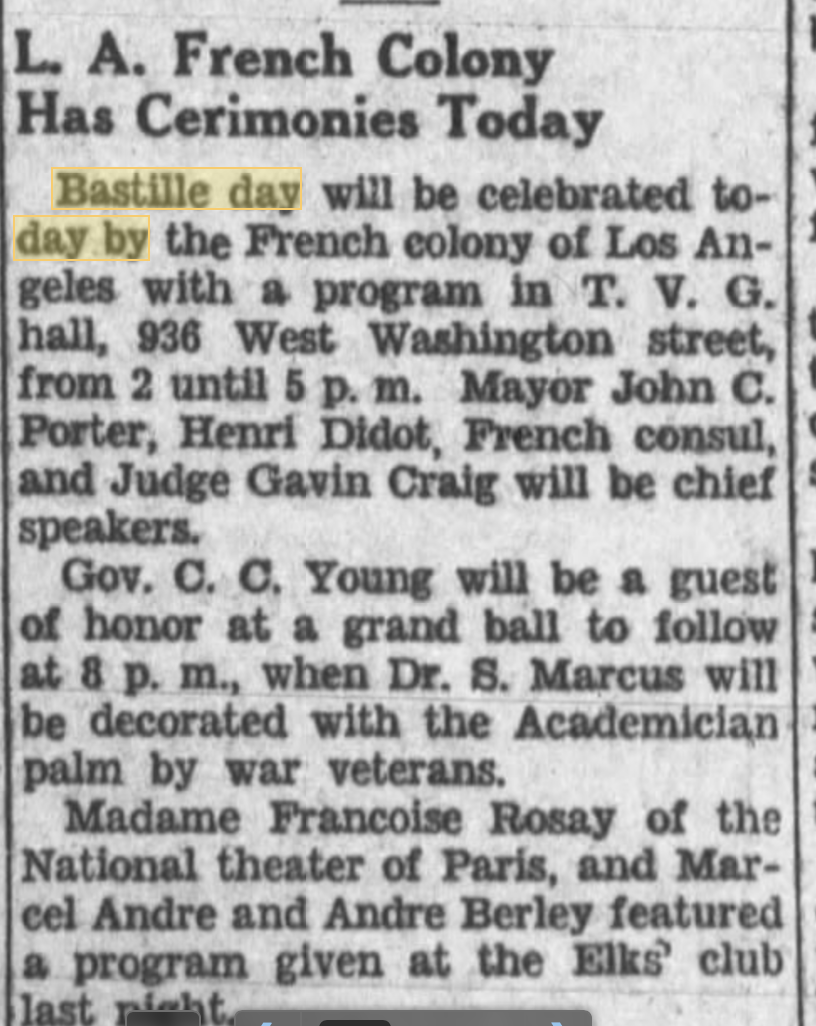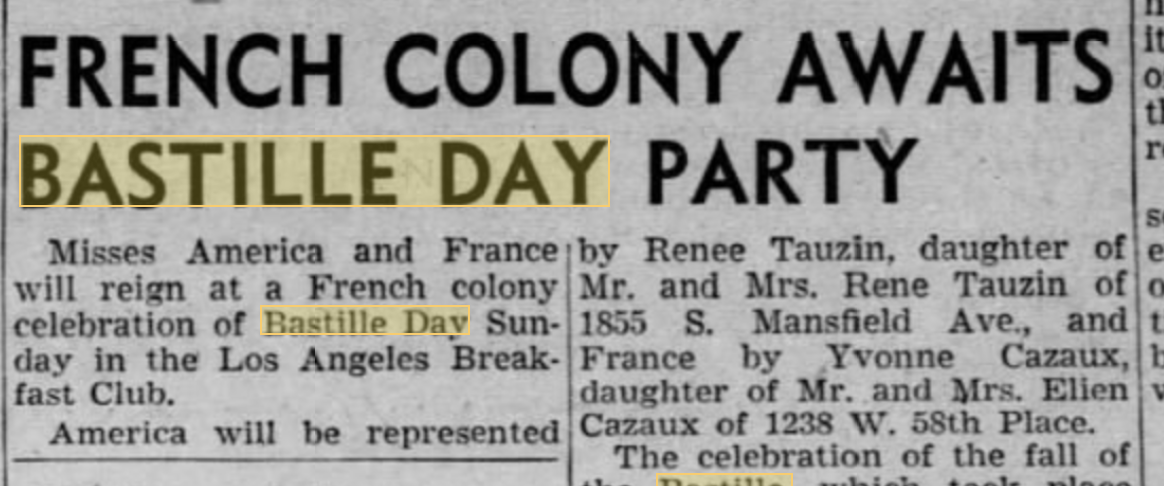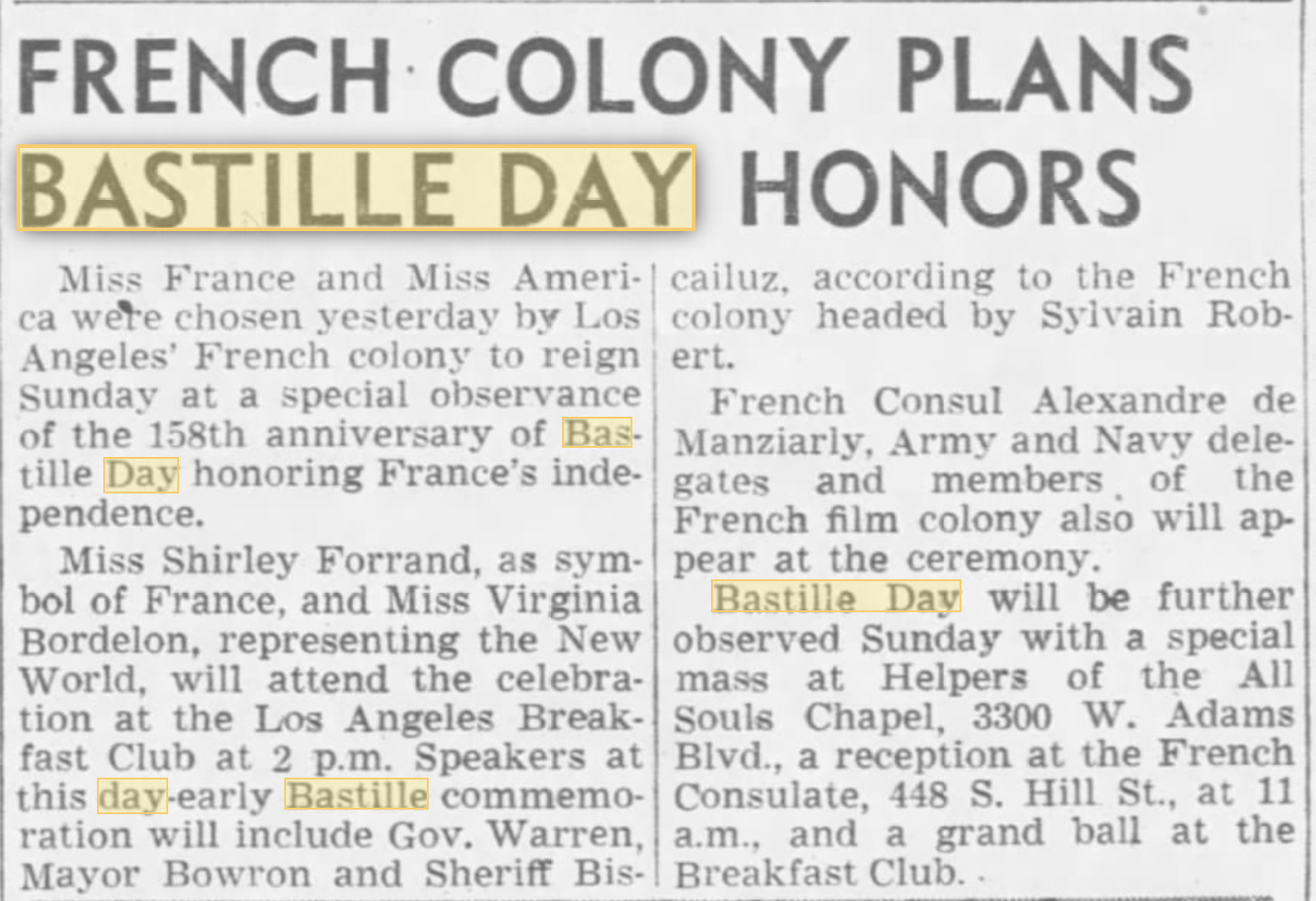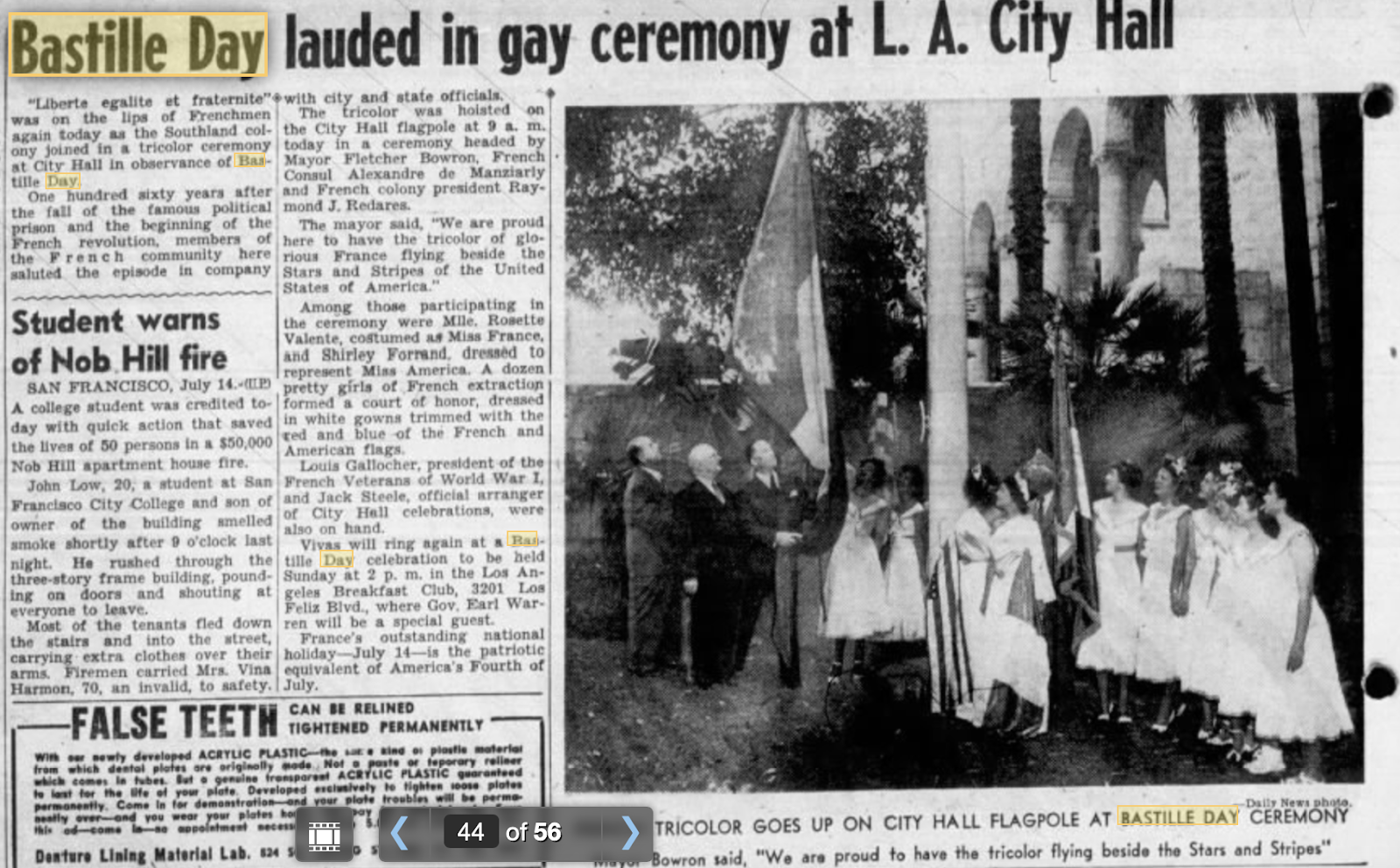There has been some debate over how many French people lived in Old Los Angeles, with estimates ranging from two percent to twenty percent.
The book Los Angeles in Civil War Days puts the figure around ten percent.
As time travel most likely isn't possible (but feel free to prove me wrong on that), and since there was a significant migration wave after 1850, I suspected the 1860 census would hold the answer. Unfortunately, most of it has not been transcribed (and I'm not about to volunteer because, like most people who grew up in the computer age, I have trouble reading frilly Victorian handwriting). I had to figure out a workaround for that.
Here are all the French, Québecois, French Swiss, Walloon, and French-American (at least one French parent) Angelenos I can find in the 1860 census (if there are any missing, please comment with citations):
Abarta family: Pedro, French. Jose, Pedro, Isabel, Emilia, and Graciosa, Californians.
Aillard, Hillarain. French.
Alexandre family: Raymond, French. Amsindo and Alexander, Californian.
Alexis, Camille. French.
Alma family: Antonio, French. Antonio (Jr.) and Florentina, Californian.
Amellac, Auguste, French.
Amestoy family: Domingo and Baptiste, French.
Aullebmy family: Jean, Carolina, and Satarina, French.
Baingust, Nicolas. French.
Baltz family: Angela, Peter, and Philip, French.
Bartolin, Antonio. French.
Beaudry, James. Québecois.
Beaudry, Victor. Québecois.
Beaugardin family: Theodore and Adeline, French.
Behn family: Adela (maiden name not listed), French. Alexander, Nieves, and Luisa, Californian.
Bernard, Jean. Swiss.
Bernick, Jean. French.
Blaine family: Jeanne and Peter, French.
Billon, Jean. French.
Biscardes, Juan. French.
Bise, Pedro and Diego (brothers). French.
Bodart, Henry. French.
Bonlantaya, Juana. French.
Bordenave, Emile. French.
Boscano, Emiliano. French.
Bouet family: Jean-Baptiste, French. Juan, Elizabeth, Alfonzo, Virginia, Guillermo, and Agustin, Californian.
Boysual, Armand. French.
Brenzin, Stanislaus. French.
Brisson, Pedro. French.
Briswalter family: Andre and Agathe, French.
Brittone, Jean. French.
Brunet family: Manuel, French. Maria S., Californian.
Brust, Martin. French.
Bry, Louis. Swiss.
Budin, Prudie. French.
Caillet, Louis. French.
Carter, Peter. French.
Caugnina family: August and Mary, French. Josephina and Alice, Californian.
Chanaca, Francisco. French.
Charles, William. French.
Clarot family: Charles and Elizabeth, French. Amado, Californian.
Claude family: Henriot, Maria, Annice, and Maria (Jr.), French. Louisa, Californian.
Clement family: Michael and Mary, French. Michel and Mary JC, Californian.
Cleobule, Blanch. French.
Cretinier, Pierre. French.
Davis, Jean. French.
Davoust, Adrien. French.
Dazzet family: Julian and Renie, French.
De Dios family: Juan (French) and Procopio (Californian).
Defoe, Joseph. French.
Delangro, Herman. French.
Delaval, Charles and Henri. French.
Delaval, Gustave. Swiss.
Deman, G. French.
Dery family: Geblin and Marie, French. Octavio and Ernest, Californian.
Docan, Juan and Pauline, French.
Domac family: Juan J, Juan B, French. Frank, Californian.
Domec family: Pierre, French. Francisca, Saladonio, and Terecia, Californian.
Dubaardoux family: Thomas, Bernarda and Lucia, French; Juana, Lucia, Amelio, Maria, and Henry, Californians.
Ducommun, Charles.
Ducommun family: Amelia, Alice, French.
Dugue, Elesac. French.
Duprat, Leon. French.
Echepare, Martin. French.
Esprit, Candita, French.
Etchemendy, Juan. French.
Etitus, Estifen. French.
Farney family: Jacob and Julia, French.
Fingar, Henrietta. French.
Flowers, Jean. French.
Fourcade, John and Theresa, French.
Francis, Jean. French.
Gaillard, Maria, French, and Maria (Jr), Californian.
Garrett, Amos. French.
Gassagua family: Charles and Mary, French.
Gassoit, Arnault. French.
Germain, Jean. French.
Gossons, Peter. French.
Gouddin, Louis. French.
Grange, Achille. French.
Gregory, Ernest. French.
Grosse, Alphonse. French.
Guiol family: Frederic, French. Children Frederic and Adolfo, Californians.
Harraway, John. French.
Hathaway, Jacob. French.
Hennaquin, Maria. French.
Humberd, Prosper. French.
Jicovis, Domingo. French.
Johns, Reitch. French.
Juanna, Philippina. French.
Jueguen, Jean. French.
Kremer family: Maurice, French. Rachel, Californian.
Kuhn, Henry. French.
Labatt, Jean. French.
Labi, Pierre. French.
Lacerol family: Pedro and Maria, French. Frederick, Californian.
Lauren, Jean. French.
Laboite family: Fernando, Mary, and Mary A. (daughter), French.
Labory family: Antonio. French. Leonardo, Californian.
Lacarde, Prosper. French.
Lachamois family: Achille and Clementine, French.
Lachenais, Michel. French.
Lacke, William. French.
Lacourer, Frank. French.
Lafare, Martin. French.
Lafon, John. Québecois.
Lalle family: Pedro, French. Juan and Pedro (Jr), Californian.
Laroche, Alexandre. French.
Lazard, Solomon and Abraham (brothers). French.
Lecor, Carlos. French.
Lecroq family: Emile and Sarah, French. Emily and Sarah (Jr.), Californian.
Lecroy family: Felix and Henry, both French.
Legran, Joseph. French.
Lehman, George. French.
Leigle, Arsenne. French.
Lelong family: Martin, French. Martin T, Martin S, Martin F, Bautista, Bernabe, Victor, Josepha - American.
Lemaire, Francois. French.
Lepaon, Honorine. French.
Liboban family: Charles, French. Maria, Californian.
Licrox family: Juan, French. Francisca, Californian.
Lincitt, Paul. French.
Lorain, Thomas. Québecois.
Louis, Magil (Miguel?). French.
Louis, Michon. French.
Louis, Stanislaus. French.
Luckhart, Charles. French.
Maes, Pedro. French.
Mano. Andre. French.
Marchessault, Damien. Québecois.
Margined, James. French.
Mascarel family: Joseph, French; Josefa, Joseph, Petronila, and Adolfo, Californian.
Maurnos, Bernard. French.
Menaker family: John, Catharine, and Mary, French.
Menards, Francisco.
Mesmer family: Louis and Catherine, French. Joseph, Californian.
Messonier, Victor. French.
Metch, Remy. French.
Meter, Francisco. French.
Moerenhault family: Jacob, Belgian (French diplomat). Antonio and Emma, born in Tahiti.
Montaln, Dennis. French.
Neven, Theodore and Celena, both French.
Pelotte, Julian. French.
Penelon, Henri. French.
Plasant family: Charles and Jean, both French.
Prudhomme family: Leon Victor, French. Maria, Charles, and Caroline, Californians.
Poulain family: Augustine and Eugenie, French. Sidonie, Leonarda, Peter, Adrien, and Honore, Californian.
Reddy, Peter. French.
Rene, Simon. French.
Ribourne, Frederic. French.
Richards, Peter. French.
Rives, Bartin. French.
Riviere, Frank. French.
Romain, Doleac. French.
Routet family: Mathias and Louise, French. Susana, Californian.
Rumebe, Joseph. French.
Sainsevain family: Louis, Jeanne, Miguela, French.
Salaveri, Isabel. French.
Sapell, Charles. French.
Sarlandie family: Jennie and Jose, French.
Sarris family: Phillipe, French. Maria and Phileciadrea, Californian.
Sassate family: Charles and Eugenie, French.
Saul, Delon. French.
Sebrala, Jean. French.
Segovia, Zula. French.
Selahon, Jose. French.
Shumacker family: Mary, French (maiden name not listed). Mary A and Caroline, Californian.
Signoret family: Felix and Catherine, French. Rosa, Californian.
Sorirel, Juan. French.
Sorness, Manuel. French.
Snyder, Clara. French.
Staats, D. French.
Tanheart, Jean. French.
Thirion, George. French.
Tunirie family: Antonio, Georgia, French. Toracia, Anota, John, American.
Vaché family: Emile and Zoe, French. Louise and Emile Jr., Californian.
Vigal, Louis. French.
Vignes family: Jean M., Jean, Jeanne, Jean-Louis, Vitale, Emma, French. Helen, Californian.
Vigo family: Antonio and Mary, French.
Weaver, Nicolas. French.
While I cannot personally guarantee the full accuracy of the census in the days of poorer record-keeping and inconsistent spellings (I found some errors - hell, I submitted several corrections to things I KNEW were transcribed wrong), this indicates 316 or so French, mixed French, and Francophone Angelenos in Los Angeles City proper.
With the 1860 population at 4,385, assuming the census is reasonably accurate, that puts LA's French community at 13.87%. Which is certainly below the twenty percent estimate, but it blows the two percent claim out of the water.
I should tackle the 1870 census next.
*Note: Yes, there are a lot of Spanish names. Many French Angelenos adopted Spanish versions of their birth names; quite a few of the families listed were mixed marriages, often with Californio, Mexican, or Native American wives; and the census does not distinguish Basques from other French or Spanish citizens. Also, any spelling errors (and I suspect quite a few of these are misspelled) are either the census takers' or the transcribers' and not my own.






